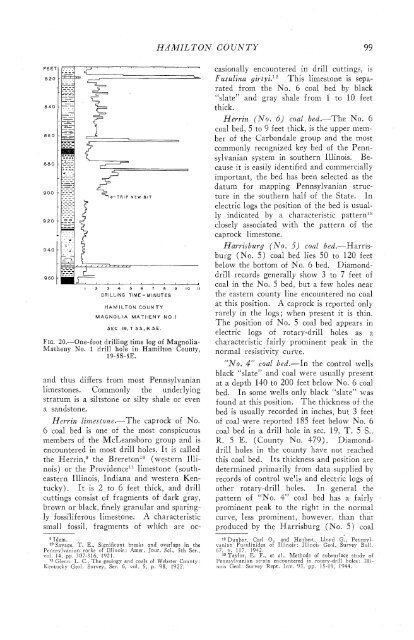subsurface geology and coal resources of the pennsylvanian system ...
subsurface geology and coal resources of the pennsylvanian system ...
subsurface geology and coal resources of the pennsylvanian system ...
You also want an ePaper? Increase the reach of your titles
YUMPU automatically turns print PDFs into web optimized ePapers that Google loves.
HAMILTON COUNTY 99<br />
FIG. 20.-<br />
Ma<strong>the</strong>ny<br />
1 2 3 4 5 6 7 8 9 1 0 1 1<br />
DRILLING TIME - MINUTES<br />
HAMILTON COUNTY<br />
MAGNOLIA MATHENY NO I<br />
SEC 19. T 5S., R.5E.<br />
-One-foot drilling time log <strong>of</strong> Magnolia-<br />
No. 1 drill hole in Hamilton County,<br />
19-5s-5E.<br />
<strong>and</strong> thus differs from most Pennsylvanian<br />
limestones. Commonly <strong>the</strong> underlying<br />
stratum is a siltstone or silty shale or even<br />
a s<strong>and</strong>stone.<br />
Herrin limestone.-The caprock <strong>of</strong> No.<br />
6 <strong>coal</strong> bed is one <strong>of</strong> <strong>the</strong> most conspicuous<br />
members <strong>of</strong> <strong>the</strong> McLeansboro group <strong>and</strong> is<br />
encountered in most drill holes. It is called<br />
<strong>the</strong> Herriqg <strong>the</strong> Brereton10 (western Illinois)<br />
or <strong>the</strong> Providence1' limestone (sou<strong>the</strong>astern<br />
Illinois, Indiana <strong>and</strong> western Kentucky).<br />
It is 2 to 6 feet thick, <strong>and</strong> drill<br />
cuttings consist <strong>of</strong> fragments <strong>of</strong> dark gray,<br />
bsown or black, finely granular <strong>and</strong> sparingly<br />
fossiliferous limestone. A characteristic<br />
small fossil, fragments <strong>of</strong> which are oc-<br />
"Idem.<br />
10 Savage, T. E., Significant breaks <strong>and</strong> overlaps in <strong>the</strong><br />
Penncyl.vanian ro-ks <strong>of</strong> Illinois: Amer. Jour. Sci., 5th Ser..<br />
101. 14, pp. 307-316, 1921.<br />
Glenn. L. C.. The <strong>geology</strong> <strong>and</strong> <strong>coal</strong>s <strong>of</strong> Webster County:<br />
Kentucky Geol. Survey, Ser. 6, vol. 5, p. 98, 1922.<br />
casionally encountered in drill cuttings, is<br />
Fusulina girtyi.12 This limestone is separated<br />
from <strong>the</strong> No. 6 <strong>coal</strong> bed by black<br />
"slate" <strong>and</strong> gray shale from 1 to 10 feet<br />
thick.<br />
Herrin (No. 6) <strong>coal</strong> bed.-The No. 6<br />
<strong>coal</strong> bed, 5 to 9 feet thick, is <strong>the</strong> upper member<br />
<strong>of</strong> <strong>the</strong> Carbondale group <strong>and</strong> <strong>the</strong> most<br />
commonly recognized key bed <strong>of</strong> <strong>the</strong> Pennsylvanian<br />
<strong>system</strong> in sou<strong>the</strong>rn Illinois. Because<br />
it is easily identified <strong>and</strong> commercially<br />
important, <strong>the</strong> bed has been selected as <strong>the</strong><br />
datum for mapping Pennsylvanian structure<br />
in <strong>the</strong> sou<strong>the</strong>rn half <strong>of</strong> <strong>the</strong> State. In<br />
electric logs <strong>the</strong> position <strong>of</strong> <strong>the</strong> bed is usually<br />
indicated by a characteristic pattern1"<br />
closely associated with <strong>the</strong> pattern <strong>of</strong> <strong>the</strong><br />
caprock limestone.<br />
Hawisburg (iVo. 5) cod bed.-Harrisburg<br />
(No. 5) <strong>coal</strong> bed lies 50 to 120 feet<br />
below <strong>the</strong> bottoni <strong>of</strong> No. 6 bed. Diamonddrill<br />
records generally show 3 to 7 feet <strong>of</strong><br />
<strong>coal</strong> in <strong>the</strong> No. 5 bed, but a few holes near<br />
<strong>the</strong> eastern county line encountered no <strong>coal</strong><br />
at this position. A caprock is reported only<br />
rarely in <strong>the</strong> logs; when present it is thin.<br />
The position <strong>of</strong> No. 5 <strong>coal</strong> bed appears in<br />
electric logs <strong>of</strong> rotary-drill holes as a<br />
characteristic fairly prominent peak in <strong>the</strong><br />
normal resistivity curve.<br />
""No. 4" <strong>coal</strong> bed.-In <strong>the</strong> coatrol wells<br />
black "slate" <strong>and</strong> <strong>coal</strong> were usually present<br />
at a depth 140 to 200 feet below No. 6 <strong>coal</strong><br />
bed. In some wells only black "slate" was<br />
found at this position. The thickness <strong>of</strong> <strong>the</strong><br />
bed is usually recorded in inches, but 3 feet<br />
<strong>of</strong> <strong>coal</strong> were reported 185 feet below No. 6<br />
<strong>coal</strong> bed in a drill hole in sec. 19, T . 5 S.,<br />
R. 5 E. (County No. 479). Diamonddrill<br />
holes in <strong>the</strong> county have not reached<br />
this <strong>coal</strong> bed. Its thickness <strong>and</strong> position are<br />
determined primarily from data supplied by<br />
records <strong>of</strong> control wells <strong>and</strong> electric logs <strong>of</strong><br />
o<strong>the</strong>r rotary-drill holes. In general <strong>the</strong><br />
pattern <strong>of</strong> "No. 4" <strong>coal</strong> bed has a fairly<br />
prominent peak to <strong>the</strong> right in <strong>the</strong> normal<br />
curve, less prominent, however, than that<br />
produced by <strong>the</strong> Harrisburg (No. 5) <strong>coal</strong><br />
12, Dunbar, Carl 0.. <strong>and</strong> Henbeqt, Lloyd G., Pennsylvanlan<br />
Fy111inidea <strong>of</strong> Illinois: Illinois Geol. Survey Bull.<br />
67. n. 111. 1912.<br />
13 Taylor, E. F., et al., Methods <strong>of</strong> <strong>subsurface</strong> study <strong>of</strong><br />
Pennsylvanian strata encountered in rotary-drill holes: Illinois<br />
Geol. Survey Rept. Inv. 93, pp. 15-19, 1944.
















